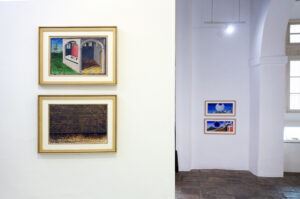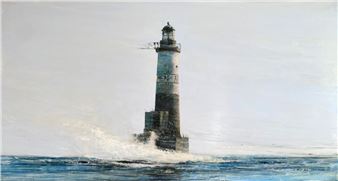JosГ© Manuel Ballester: The Decameron / The Divine Comedy
For two decades, José Manuel Ballester has been working on a line of research entitled “Hidden Spaces,” which takes its inspiration from emblematic paintings in art history. This series revisits our iconographic past, with the distinctive feature that the main protagonists of the work have been removed. By leaving only the background, a space that is normally silent in the service of what is being told, the narrative part is nullified and an ambiguous interstice is created where the scene hidden behind the foreground prevails in a suggestive way. This eloquent void, created by deactivating the characters’ actions, reveals an omitted version of something we thought we knew, an unpublished image that takes on new life and awakens unexpected interpretations beyond its original meaning.
Now, to mark the start of the season at the Rafael Ortiz Gallery in Seville, Ballester presents the latest works from this visual investigation, two complementary groups of photographs that take us back to the beginnings of Western painting and the construction of the modern gaze in Europe. On the one hand, we find a selection of miniatures inspired by Dante Alighieri’s Divine Comedy, created by Giovanni di Paolo in the mid-15th century in Siena. On the other, we find decontextualized scenes taken from Boccaccio’s Decameron, painted by the master Jean Mansel in the circle of the Duke of Burgundy in France during the same period. Both sets are taken from illuminated manuscripts that illustrate two of the pillars of universal Italian literature. In reality, these types of creations represent the transition between a world that is ending and another that is beginning: the Renaissance. The miniatures tell a visual story in vignettes. In them, the Byzantine style is gradually abandoned in favor of a three-dimensional conception of space that, starting in northern Italy, would soon spread throughout the territories. The background supporting the composition reveals rooms and houses, fortresses and walls, distant horizons. Mountains, hills, and trees. The transition between interiors and exteriors predominates, a model that was already being used at that time for statements and where architecture outlined the beginnings of a new formal language in which the invention of perspective and landscape would gradually take on greater prominence.
Before the advent of the printing press and the consolidation of humanism, illuminated books were an important repository of knowledge. From the 13th century onwards, this knowledge began to leave the monasteries and be developed in specialized workshops that were sometimes linked to the emerging universities. Most manuscripts were made on parchment and were commissioned by kings or nobles, but also by merchants.
n the Late Middle Ages, the dissemination of non-religious books or books exclusively for prayer became increasingly common, especially works such as The Decameron and The Divine Comedy, which were already considered masterpieces and enjoyed great popularity in their day. Furthermore, as they were written in Italian rather than Latin, they were fundamental to the consolidation of this vernacular language. For some artists, these images included in the manuscripts were a laboratory in which to experiment with ideas, forms, and colors that were later developed in the Trecento and Quattrocento.
The latent spaces that JosГ© Manuel Ballester manages to activate prompt an open reflection on the way in which ways of seeing took root in our culture, focusing here in particular on the origins of Renaissance painting. He has silently removed everything that is obvious to reveal to us, through a metalinguistic exercise that intertwines painting and photography, the hidden layers that lie beneath a superficial glance. His proposal confirms that the eye and the mind must always be connected.

For two decades, José Manuel Ballester has been working on a line of research entitled “Hidden Spaces,” which takes its inspiration from emblematic paintings in art history. This series revisits our iconographic past, with the distinctive feature that the main protagonists of the work have been removed. By leaving only the background, a space that is normally silent in the service of what is being told, the narrative part is nullified and an ambiguous interstice is created where the scene hidden behind the foreground prevails in a suggestive way. This eloquent void, created by deactivating the characters’ actions, reveals an omitted version of something we thought we knew, an unpublished image that takes on new life and awakens unexpected interpretations beyond its original meaning.
Now, to mark the start of the season at the Rafael Ortiz Gallery in Seville, Ballester presents the latest works from this visual investigation, two complementary groups of photographs that take us back to the beginnings of Western painting and the construction of the modern gaze in Europe. On the one hand, we find a selection of miniatures inspired by Dante Alighieri’s Divine Comedy, created by Giovanni di Paolo in the mid-15th century in Siena. On the other, we find decontextualized scenes taken from Boccaccio’s Decameron, painted by the master Jean Mansel in the circle of the Duke of Burgundy in France during the same period. Both sets are taken from illuminated manuscripts that illustrate two of the pillars of universal Italian literature. In reality, these types of creations represent the transition between a world that is ending and another that is beginning: the Renaissance. The miniatures tell a visual story in vignettes. In them, the Byzantine style is gradually abandoned in favor of a three-dimensional conception of space that, starting in northern Italy, would soon spread throughout the territories. The background supporting the composition reveals rooms and houses, fortresses and walls, distant horizons. Mountains, hills, and trees. The transition between interiors and exteriors predominates, a model that was already being used at that time for statements and where architecture outlined the beginnings of a new formal language in which the invention of perspective and landscape would gradually take on greater prominence.
Before the advent of the printing press and the consolidation of humanism, illuminated books were an important repository of knowledge. From the 13th century onwards, this knowledge began to leave the monasteries and be developed in specialized workshops that were sometimes linked to the emerging universities. Most manuscripts were made on parchment and were commissioned by kings or nobles, but also by merchants.
n the Late Middle Ages, the dissemination of non-religious books or books exclusively for prayer became increasingly common, especially works such as The Decameron and The Divine Comedy, which were already considered masterpieces and enjoyed great popularity in their day. Furthermore, as they were written in Italian rather than Latin, they were fundamental to the consolidation of this vernacular language. For some artists, these images included in the manuscripts were a laboratory in which to experiment with ideas, forms, and colors that were later developed in the Trecento and Quattrocento.
The latent spaces that JosГ© Manuel Ballester manages to activate prompt an open reflection on the way in which ways of seeing took root in our culture, focusing here in particular on the origins of Renaissance painting. He has silently removed everything that is obvious to reveal to us, through a metalinguistic exercise that intertwines painting and photography, the hidden layers that lie beneath a superficial glance. His proposal confirms that the eye and the mind must always be connected.

 ARTISTS
ARTISTS











